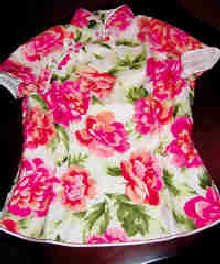
Elegant ladies, including movie starts and noblewomen, had many different ways to wear the cheongsam: a partial Western style with a matching surcoat (an outside coat of rich material). Partial western style meant that the collar and sleeves were tailored according to the western-style fashion's craft such as the lapel, lotus-leaf-like sleeves, flouncing lap and so on.
However, the majority of women preferred to wear the cheongsam with a western-style costume, such as, for example, wearing a cheongsam with a western-style coat, fur coat, or woolen coat and vest outside. Or the women would tie a scarf around the cheongsam or attach fancy decorations to the dress. All of these styles could show the women's brilliant and charming figure.
Neatness was a new trend of the cheongsam in the 1940s, reflected most progressively in summer, when the cheongsam generally was sleeveless, shorter in both length and collar height, and not over-laden with decorations, which made it lighter and more suitable for the body.
At the same time, the slender cheongsam, with a woman's marcel (deep wavy hair), silk stockings, high-heeled shoes, necklaces, earbobs (earrings) and handbags, was the most fashionable attire for women. Later, a kind of improved cheongsam with western tailoring craft developed, which made the cheongsam more fitted and applicable. The cheongsam, then, turned into a Chinese national dress with a unique style.
It can be said that without modern Shanghai's opening to the world or the combination of the Chinese and Occidental cultures, there would be neither the Western-style cheongsam nor the Shanghai-style cheongsam.
 An International Fashion Center in Modern Times
An International Fashion Center in Modern Times
In the 1950s and early 1960s, people wore simple dresses, usually blue ot gray, and no make-up. Men wore Zhongshan, Lenin, and student dresses as the main attire, while women mostly wore short Chinese-style coats and skirts with the buttons down the front and narrow sleeves.
In the mid 1960s, the grass-green-color military uniform was very popular among the people, no matter male or female.
Since the reform and opening-up in the 1980s, the national economy has been developing rapidly, enabling people to pay increasingly more attention to their attire and make-up, according to the trend of individualism and fashionableness. Accordingly, Shanghai has again gradually become one of the international fashion centers just like Paris in France and Milan in Italy.
